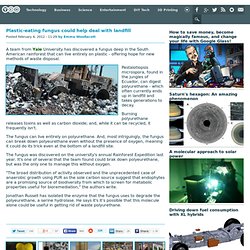

Plastic-eating fungus could help deal with landfill. A team from Yale University has discovered a fungus deep in the South American rainforest that can live entirely on plastic - offering hope for new methods of waste disposal.

Pestalotiopsis microspora, found in the jungles of Ecuador, can digest polyurethane - which often currently ends up in landfill and takes generations to decay. Burning polyurethane releases toxins as well as carbon dioxide; and, while it can be recycled, it frequently isn't. The fungus can live entirely on polyurethane. And, most intriguingly, the fungus can break down polyeurethane even without the presence of oxygen, meaning it could do its trick even at the bottom of a landfill site. The fungus was discovered on the university's annual Rainforest Expedition last year. Jonathan Russell has isolated the enzyme that the fungus uses to degrade the polyeurethane, a serine hydrolase. @iron_ammonite - Wildlife & TV: The Deadliest place on Earth? Surviving Cueva de los Cristales - The Giant Crystal Cave. Summary: Filming in the Giant Crystal Cave, one of the deadliest places on the planet.

For BBC series 'How Earth Made Us' & National Geographic Series 'How The Earth Changed History'. It's 50oC and has a humidity of 100%, less than a couple of hundred people have been inside and it's so deadly that even with respirators and suits of ice you can only survive for 20 minutes before your body starts to fail. It’s the nearest thing to visiting another planet – it’s going deep inside our own.
Highway to Hell My director, Nigel Walk and I, arrived in the quiet town of Naica as the morning sun painted the Chihuuahua desert a golden hue - it was a serene moment of calm that wasn't to last long. 1000 feet down, we arrived at the control room where conditions were already an exhausting 45oC and 55% humidity. The control room. ‘You think this is hot’ said Gonzalo gesturing towards a vaulted iron door ‘This is just a cool breeze compared to what you’ll feel like in there’… ‘ready to go?’ Aborted relics. The Economics of Happiness. In the last few years, a growing number of economists have been discovering happiness. It's not that they are spending more time admiring flowers, helping old folks cross the road, dancing on the street or baking pies for neighbors.
In fact, these happiness economists are working long hours in soul-numbing ways, torturing data with their latest econometric techniques to force deeply buried facts to the surface. What is different is that these economists are revisiting old assumptions and asking new questions. They're not taking the neoclassical model of rational economic man for truth. They have been willing to learn from their colleagues in psychology. Not everyone is welcoming this new research program. I talked to Rafael Di Tella, an Argentinean economist at the Harvard Business School who is deeply involved in happiness research.
"Another example is when one person works harder to improve their income, and feels extra well-being from greater consumption. 12 bizarre real-life places that are stranger than science fiction. Science fiction is home to some fantastic societies, from Cloud City to Bartertown.

But you doesn't have to leave reality for this—our own world has places so abnormal, they make alien societies seem ordinary. Here are 12 remarkable locations in which people once lived (and some still do). 1. Izu Islands Off the coast of Japan lies a series of volcanic islands. 2. Neft Daslari is a functional city built 34 miles from the nearest shore. 3. One of the creepiest places on Earth, Sedlec Ossuary is a Roman Catholic chapel in the Czech Republic. 4. Temperatures in this Australian mining town reach well into broiling, so the opal miners who live there have built most of their town underground. 5. In 1962, a huge underground coal deposit ignited beneath the town of Centralia, Pa. 6. It's funny how something as boring as zoning regulations could lead to one of the most exciting office buildings on the planet. 7.
Inside a spectacular Spanish church sits an enormous glass box. 20 Mind Blowing Facts You Probably Didn’t Know. 137 Freaky Wikipedia Entries.